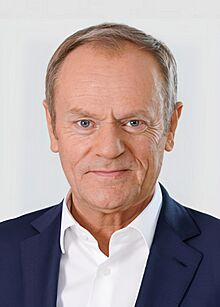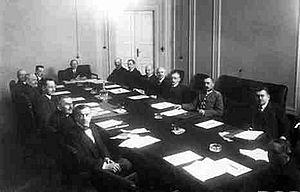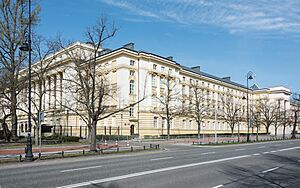Prime Minister of Poland facts for kids
Quick facts for kids President of theCouncil of Ministers |
|
|---|---|

State flag of Poland
|
|
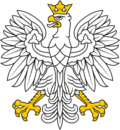
Logo used by institutions of the
Polish Government |
|
| Council of Ministers Chancellery of the Prime Minister |
|
| Style | Mr Prime Minister (informal) His Excellency (diplomatic) |
| Member of | European Council |
| Residence | Hotel "Parkowa", Warsaw (official, rarely used) |
| Seat | Building of the Chancellery of the Prime Minister |
| Appointer | President or Sejm |
| Precursor | Prime minister of the Kingdom of Poland |
| Formation | 6 November 1918 |
| First holder | Ignacy Daszyński |
| Deputy | Deputy Prime Minister |
| Salary | 389,516 Polish zloty/€81,772 annually |
The President of the Council of Ministers in Poland is usually called the Prime Minister. This person is the main leader of the cabinet (a group of top government officials) and the head of government for Poland. The job's duties and traditions come from when the modern Polish state was created. The Constitution of Poland explains what the Prime Minister does.
According to the Constitution, the President chooses and appoints the Prime Minister. The Prime Minister then suggests who should be in the cabinet. Within 14 days of being appointed, the Prime Minister must present the government's plan to the Sejm (Poland's main parliament). The Sejm then votes to show if they trust the new government. Sometimes, the President and Prime Minister have had disagreements about their powers.
The current Prime Minister is Donald Tusk from the Civic Platform party. He became Prime Minister on December 13, 2023. He took over from Mateusz Morawiecki after the 2023 Polish parliamentary election. Morawiecki's government did not get enough votes of confidence from the Sejm. Tusk's government then received the necessary votes and was sworn in. Tusk was also Prime Minister before, from 2007 to 2014.
Contents
How the Prime Minister's Job Started
The Second Polish Republic (1918-1939)
After World War I, different groups wanted to create an independent Poland. In November 1918, a temporary government led by Ignacy Daszyński declared independence. Marshal Józef Piłsudski became the Chief of State. Piłsudski asked Daszyński to form the first government, making him the first Prime Minister. However, Daszyński could not form a strong group, so Piłsudski chose Jędrzej Moraczewski, who successfully created a working government for the new Second Polish Republic.
The Small Constitution of 1919 set up Poland's government. It included a democratically elected Sejm, a Prime Minister, a cabinet, and an executive branch. Even though it was a parliamentary system, Piłsudski, as Chief of State, had a lot of power. He could choose and organize cabinets (with the Sejm's approval). Later, the March Constitution of 1921 gave most power to the Sejm. The new presidency became a mostly symbolic role with little power.
Because the Sejm was so powerful, the Prime Minister and cabinet theoretically had few limits from the President. But in reality, the Prime Minister's job was very unstable. There were many political changes, and governments often fell quickly. Between 1918 and 1926, Poland had 14 different governments and 11 Prime Ministers. This made Piłsudski unhappy. In 1926, he led a military takeover called the May Coup. This ended Poland's short time as a full parliamentary democracy.
After the May Coup, Piłsudski and his Sanation movement had a lot of control over the government. The Prime Minister's role continued, but the President's powers grew. By 1935, a new constitution made the President very strong. The President could now dismiss parliament, appoint and dismiss the Prime Minister, cabinet members, and judges freely. The President became the supreme power in the state. This continued until World War II.
The Polish People's Republic (1945-1989)
During the time of communist rule in Poland, the Polish United Workers' Party (PZPR) controlled everything. The Prime Minister's job still existed, but its power depended more on how important the person was within the communist party. The Prime Minister mostly carried out policies decided by the party's leaders.
In the 1980s, the Solidarity movement led many protests. This led to the Round Table Talks in 1989 between the communist party and the anti-communist opposition. These talks led to changes in the constitution. The Sejm gained more power, and the Senate (an upper house of parliament) and the presidency were brought back.
The Third Polish Republic (1989-Present)
After the 1989 Polish parliamentary election, the government led by Tadeusz Mazowiecki from the Solidarity movement had to define the Prime Minister's powers. The early years of the Third Republic had many unstable governments. The role of the President, which was brought back during the Round Table Talks, was also not clearly defined.
When Lech Wałęsa was directly elected President in 1990, a struggle began between the Prime Minister and the President over their powers. Wałęsa wanted more presidential powers, including the right to appoint and dismiss the Prime Minister and cabinet members. He later changed his mind about creating a full presidential system, but still wanted a system like France's, where both the President and Prime Minister share power.
The Small Constitution of 1992 helped clarify some of the President's powers over the Prime Minister. For example, the President had to be consulted about the ministers of Defense, Foreign Affairs, and Interior. Even with these changes, power struggles continued, especially between President Wałęsa and the Sejm.
However, after the 1993 Polish parliamentary election and Wałęsa's defeat in the 1995 Polish presidential election, there was a push for bigger constitutional changes. Between 1996 and 1997, new laws were passed that made the Prime Minister's role stronger. These changes became part of the current 1997 Constitution.
Important changes included:
- The Prime Minister could now call for a vote of confidence in their government.
- The Prime Minister had the only right to choose and change ministers in the cabinet.
- The Prime Minister alone decided what each ministry would be responsible for.
Many of these new powers for the Prime Minister came from the President, who lost the right to consult on ministerial appointments, reject cabinet choices, or veto the budget. The old Office of the Council of Ministers was also changed into the Chancellery in 1997. This office helps the Prime Minister and supports the cabinet. These reforms made the Prime Minister the main center of power in the government.
Choosing the Prime Minister and Their Duties
How the Prime Minister is Appointed
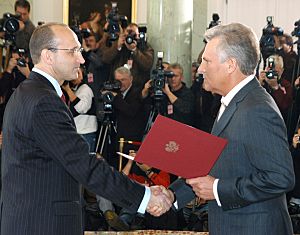
According to Article 154 of the Polish Constitution, the President nominates the Prime Minister. Usually, the President chooses the leader of the party that won the most seats in the last election, or the leader of the main party in a group of parties (coalition). The President cannot simply dismiss the Prime Minister or individual cabinet members whenever they want.
Once chosen, the Prime Minister suggests who should be in the cabinet. Within 14 days, they must present their government's plan to the Sejm. The Sejm then votes to show if they trust the new government. If the vote fails, the Sejm gets to nominate a Prime Minister within 14 days. If the Sejm's choice is approved by a majority vote, the President must accept and swear them in. If this second vote of confidence also fails, the President again appoints a Prime Minister and cabinet. If the vote fails a third time, the President must dissolve the Sejm and call new elections.
As part of tradition, the Prime Minister and ministers take an oath of office at the Presidential Palace. They promise to be loyal to the Constitution and laws of Poland, and to always put the good of the country and its citizens first. They can also add, "So help me God."
The Prime Minister's Role and Powers
Article 148 of the constitution says that the Prime Minister represents the entire cabinet. They set the agenda, coordinate the work of ministers, make sure government policies are carried out, and issue regulations. The Prime Minister is also in charge of all civil servants (government employees). The Prime Minister is helped by a Deputy Prime Minister (or several), who acts as a vice-president within the cabinet. The way the cabinet works depends a lot on the Prime Minister's personality.
The Prime Minister cannot also be the President or hold other high state offices, like the head of the Supreme Audit Office or the National Bank. The Prime Minister can also take on the duties of a minister if needed. They can also ask the cabinet to cancel a rule or order from any minister.
The Prime Minister must answer questions from members of the Sejm during every meeting. The Prime Minister and other ministers must also respond to formal questions from deputies within 21 days.
In Poland's system, most official actions by the President need the Prime Minister's signature to become valid. This means the Prime Minister acts as a "gatekeeper" for some of the President's actions and takes responsibility for them to the Sejm. This makes the Prime Minister's role very important. However, the President does not need the Prime Minister's signature for a few specific actions, like appointing judges or giving out awards. The President's most important power over the Prime Minister is the right to veto (reject) government laws. But the Sejm can overrule this veto with a three-fifths majority vote.
The Prime Minister can also ask the Sejm for a vote of confidence in their cabinet. If the cabinet loses the support of the Sejm, it can be forced to resign through a constructive vote of no confidence. This motion needs at least 46 deputies to propose it and then a majority vote to pass. If it passes, a new Prime Minister must be chosen at the same time.
The Prime Minister must also resign their cabinet when a new parliament is elected, after a vote of no confidence, or if they resign themselves. If the Prime Minister resigns or dies, the President can choose to accept or refuse the cabinet's resignation.
For the regional governments in Poland's 16 provinces (called voivodeships), the Prime Minister appoints a voivode for each. These voivodes oversee the central government's work in the regions and local government functions. The Sejm, at the Prime Minister's request, can dissolve a local or regional government if it is clearly breaking the constitution or laws.
The Prime Minister also has emergency and security powers. They can ask the President to appoint a military commander-in-chief during wartime or order a partial or full mobilization if national security is threatened. The Prime Minister also has the right to appoint and dismiss the heads of special services, like the police, border guard, and intelligence agencies. If there is public disorder, the Prime Minister can authorize special police units to restore order. If these units are not enough, the Prime Minister can ask the President to deploy the Polish Armed Forces.
Relationship with the President
Throughout the history of the Third Republic, the relationship between the Prime Minister and the President has changed. In the early 1990s, it depended on how each office's powers were understood. Since the 1997 Constitution, it has mostly depended on political differences and the personalities of the leaders. Conflicts between the two offices have sometimes caused political problems.
Early on, President Lech Wałęsa had a difficult relationship with Prime Minister Tadeusz Mazowiecki. Wałęsa felt Mazowiecki was not tough enough in removing former communist party members from government jobs. This disagreement caused a split in the original Solidarity movement.
Prime Minister Jan Olszewski also had a strained relationship with President Wałęsa between 1991 and 1992. Olszewski's economic approach differed from Wałęsa's. Wałęsa wanted to increase presidential powers, while Olszewski tried to weaken the President's standing. Wałęsa repeatedly called for Olszewski's government to be dismissed, which happened in June 1992. However, Prime Minister Hanna Suchocka, who came after, had a much better relationship with the President.
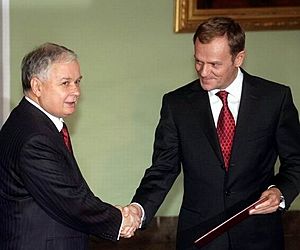
The 1997 Constitution greatly changed the relationship between the Prime Minister and the President. It removed many of the uncertainties about their powers, making it harder for the President to completely disrupt the government and strengthening the Prime Minister's position. Under President Aleksander Kwaśniewski, Prime Minister Jerzy Buzek's government was the first to be elected under the new constitution. Even though they were from different parties, their relationship was smooth, partly because Kwaśniewski was not confrontational.
However, relations became tense again under President Lech Kaczyński and Prime Minister Donald Tusk. They had been political rivals for years. Tusk's party won the 2007 Polish parliamentary election, defeating Kaczyński's brother's government. Tusk wanted stronger integration with the European Union and better relations with Russia, which Kaczyński disagreed with. From 2007 until Kaczyński's death in 2010, their policy differences caused constant division. The President often used his limited veto powers, and Tusk's government did not have enough votes to overturn these vetoes. Tusk openly stated his party's desire to replace Kaczyński in the 2010 presidential election.
In 2015, President Andrzej Duda and Prime Minister Ewa Kopacz also had a tense relationship. Duda asked for no major political changes before he was sworn in, but Kopacz said the government had duties to fulfill.
Duda's relationships with conservative Prime Ministers Beata Szydło and Mateusz Morawiecki were mostly without conflict. Duda rarely used his veto powers on laws he disagreed with.
However, relations between President Duda and Prime Minister Tusk became tense again after the 2023 election. Duda initially re-appointed Morawiecki as Prime Minister, even though the opposition parties had formed a coalition and agreed to nominate Tusk. Morawiecki's new cabinet was called the "two-week government" because it was expected to be very short-lived. Duda later said he would veto the government's amended 2024 spending bill, citing issues with funding public media. Tusk responded that the President's veto would take money away from teachers. Duda signed the budget bill on January 31, 2024, but sent it to the constitutional court, raising doubts about its adoption. Tusk said the budget was approved and people would get their money. In April 2024, the Sejm approved a bill recognizing Silesian as an official regional language, but Duda vetoed it on May 29, 2024. Tusk criticized this decision. On August 16, 2024, Duda vetoed a bill that would have disbanded a commission investigating Russian influence. On March 11, 2025, President Duda vetoed a bill that would have changed how the Supreme Court validates presidential election results. On April 17, 2025, the President sent a bill to the Constitutional Tribunal that would expand hate crime laws to include sexual orientation, sex/gender, age, and disability.
Support Staff and Residence
The Prime Minister's main office is called the Chancellery. It is located in the Building of the Chancellery of the Prime Minister in Warsaw. This building is where the cabinet holds its meetings. The Chancellery helps the Prime Minister and ministers work together on government policies. It also provides support staff for the Prime Minister and shares government information. The Chancellery also includes other departments that report directly to the Prime Minister, such as the Economic Council and the Civil Service Department.
The official home of the Prime Minister is Willa Parkowa, which is near the Chancellery in Warsaw. However, former Prime Minister Donald Tusk chose to live in Sopot, near his hometown of Gdańsk.
The Prime Minister receives security from the Government Protection Bureau while in office and for six months after leaving the job.
List of Polish Prime Ministers
Since the Third Republic began, 16 people have served as Prime Minister. The shortest-serving government was the third government of Mateusz Morawiecki, which lasted only 16 days in late 2023. The longest-serving Prime Minister has been Donald Tusk, who held the position from November 16, 2007, to September 22, 2014, and again since December 13, 2023. So far, three women have been Prime Ministers: Hanna Suchocka, Ewa Kopacz, and Beata Szydło.
Democratic Union (UD) Liberal Democratic Congress (KLD) Centre Agreement (PC) Polish People's Party (PSL) Social Democracy (SdRP) / Democratic Left Alliance (SLD) Solidarity Electoral Action (AWS) Law and Justice (PiS) / United Right (ZP) Civic Platform (PO) / Civic Coalition (KO)
| No. | Name | Took office | Left office | Party | Coalition partner(s) | Term in office |
|---|---|---|---|---|---|---|
| 1 | Tadeusz Mazowiecki | 24 August 1989 | 4 January 1991 | Solidarity Citizens' Committee (KO‘S’)/ Democratic Union (UD) |
ZSL–PZPR | 1 year, 133 days |
| 2 | Jan Krzysztof Bielecki | 4 January 1991 | 6 December 1991 | Liberal Democratic Congress (KLD) | ZChN–PC–SD | 336 days |
| 3 | Jan Olszewski | 6 December 1991 | 5 June 1992 | Centre Agreement (PC) | ZChN–PSL.PL-PChD | 182 days |
| 4 | Waldemar Pawlak | 5 June 1992 | 10 July 1992 | Polish People's Party (PSL) | None | 35 days |
| 5 | Hanna Suchocka | 11 July 1992 | 26 October 1993 | Democratic Union (UD) | KLD–ZChN–PChD–PPPP–PSL.PL-PPG-SLCh | 1 year, 107 days |
| 6 | Waldemar Pawlak | 26 October 1993 | 7 March 1995 | Polish People's Party (PSL) | SLD–UP–BBWR | 1 year, 132 days |
| 7 | Józef Oleksy | 7 March 1995 | 7 February 1996 | Social Democracy (SdRP) | PSL | 337 days |
| 8 | Włodzimierz Cimoszewicz | 7 February 1996 | 31 October 1997 | Social Democracy (SdRP) | PSL | 1 year, 266 days |
| 9 | Jerzy Buzek | 31 October 1997 | 19 October 2001 | Solidarity Electoral Action (AWS) | UW–SKL–ZChN–PPChD | 3 years, 353 days |
| 10 | Leszek Miller | 19 October 2001 | 2 May 2004 | Democratic Left Alliance (SLD) | UP–PSL | 2 years, 196 days |
| 11 | Marek Belka | 2 May 2004 | 31 October 2005 | Democratic Left Alliance (SLD) | UP | 1 year, 182 days |
| 12 | Kazimierz Marcinkiewicz | 31 October 2005 | 14 July 2006 | Law and Justice (PiS) | SRP–LPR | 256 days |
| 13 | Jarosław Kaczyński | 14 July 2006 | 16 November 2007 | Law and Justice (PiS) | SRP–LPR | 1 year, 125 days |
| 14 | Donald Tusk | 16 November 2007 | 22 September 2014 | Civic Platform (PO) | PSL | 6 years, 310 days |
| 15 | Ewa Kopacz | 22 September 2014 | 16 November 2015 | Civic Platform (PO) | PSL | 1 year, 55 days |
| 16 | Beata Szydło | 16 November 2015 | 11 December 2017 | United Right (ZP) | Agreement–United Poland | 2 years, 25 days |
| 17 | Mateusz Morawiecki | 11 December 2017 | 13 December 2023 | United Right (ZP) | United Poland | 6 years, 2 days |
| 18 | Donald Tusk | 13 December 2023 | Incumbent | Civic Coalition (KO) | PSL-PL2050-NL | 2 years, 7 days |
See also
 In Spanish: Primer ministro de Polonia para niños
In Spanish: Primer ministro de Polonia para niños
- Cabinet of Poland
- Deputy Prime Minister of Poland
- List of Polish monarchs
- President of Poland
- Sejm
- Senat


